
Mantua is a city and comune in Lombardy, Italy, and capital of the province of the same name.
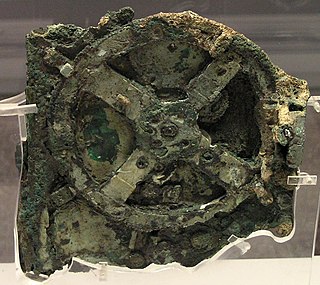
The Antikythera mechanism is an ancient Greek hand-powered orrery, described as the oldest example of an analogue computer used to predict astronomical positions and eclipses decades in advance. It could also be used to track the four-year cycle of athletic games which was similar to an Olympiad, the cycle of the ancient Olympic Games. This artefact was among wreckage retrieved from a shipwreck off the coast of the Greek island Antikythera in 1901. On 17 May 1902 it was identified as containing a gear by archaeologist Valerios Stais. The device, housed in the remains of a 34 cm × 18 cm × 9 cm wooden box, was found as one lump, later separated into three main fragments which are now divided into 82 separate fragments after conservation efforts. Four of these fragments contain gears, while inscriptions are found on many others. The largest gear is approximately 13 centimetres (5.1 in) in diameter and originally had 223 teeth. In 2008, a team led by Mike Edmunds and Tony Freeth at Cardiff University used modern computer x-ray tomography and high resolution surface scanning to image inside fragments of the crust-encased mechanism and read the faintest inscriptions that once covered the outer casing of the machine. This suggests it had 37 meshing bronze gears enabling it to follow the movements of the Moon and the Sun through the zodiac, to predict eclipses and to model the irregular orbit of the Moon, where the Moon's velocity is higher in its perigee than in its apogee. This motion was studied in the 2nd century BC by astronomer Hipparchus of Rhodes, and it is speculated that he may have been consulted in the machine's construction. There is speculation that a portion of the mechanism is missing and it also calculated the positions of the five classical planets.

Clock towers are a specific type of structure which house a turret clock and have one or more clock faces on the upper exterior walls. Many clock towers are freestanding structures but they can also adjoin or be located on top of another building. Some other buildings also have clock faces on their exterior but these structures serve other main functions.

The Prague Astronomical Clock or Prague Orloj is a medieval astronomical clock attached to the Old Town Hall in Prague, the capital of the Czech Republic.
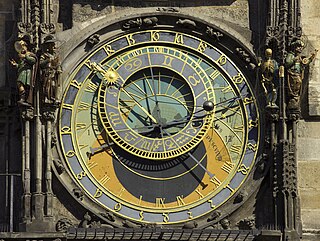
An astronomical clock, horologium, or orloj is a clock with special mechanisms and dials to display astronomical information, such as the relative positions of the Sun, Moon, zodiacal constellations, and sometimes major planets.
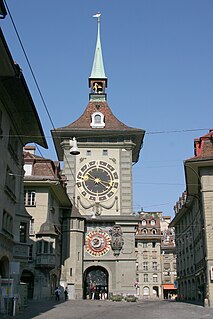
The Zytglogge is a landmark medieval tower in Bern, Switzerland. Built in the early 13th century, it has served the city as guard tower, prison, clock tower, centre of urban life and civic memorial.
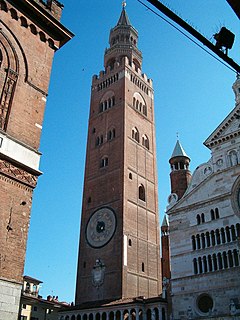
The Torrazzo is the bell tower of the Cathedral of Cremona, Lombardy, in northern Italy.

St Mark's Clock is housed in the Clock Tower on the Piazza San Marco in Venice, Italy, adjoining the Procuratie Vecchie. The first clock housed in the tower was built and installed by Gian Paolo and Gian Carlo Rainieri, father and son, between 1496 and 1499, and was one of a number of large public astronomical clocks erected throughout Europe during the 14th and 15th centuries. The clock has had an eventful horological history, and been the subject of many restorations, some controversial.

Hampton Court astronomical clock is a sixteenth-century astronomical clock in Hampton Court Palace.

The Exeter Cathedral Astronomical Clock is a fifteenth-century astronomical clock in Exeter Cathedral, England. It displays the hour of the day, the day of the lunar month and the phase of the moon. The modern clock mechanism was installed in 1885 by Gillett & Bland of Croydon, and restored in 1910.

The Astrarium of Giovanni Dondi dell'Orologio was a complex astronomical clock built between 1348 and 1364 in Padova, Italy, by the doctor and clock-maker Giovanni Dondi dell'Orologio. The Astrarium had seven faces and 107 moving parts; it showed the positions of the sun, the moon and the five planets then known, as well as religious feast days. It was one of the first mechanical clocks to be built in Europe.

Torre dell'Orologio, is a clock tower located in the Piazza (Plaza) Dei Signori and positioned between the Palazzo (Palace) del Capitanio and the Palazzo dei Camerlenghi in Padua, or Padova, Italy. It is also referred to as the astronomical clock of Padua.

Castel Goffredo Town Hall and Loggia della Magnifica Comunità are located in Piazza Mazzini in Castel Goffredo, in the Province of Mantua (Italy). It is the seat of the municipality.

The Civic Tower is a historic building in the town of Castel Goffredo, in the province of Mantua, Italy.

The astronomical clock of Messina is an astronomical clock constructed by the Ungerer Company of Strasbourg in 1933. It is built into the campanile of Messina Cathedral.
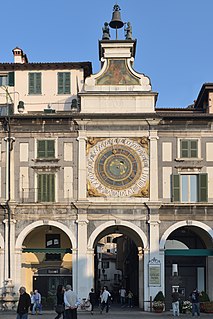
The Torre dell'Orologio is a 16th-century building located in the Piazza della Loggia in Brescia, Italy.

The Zytturm is a 13th-century tower in Zug, Switzerland, which houses an astronomical clock. The tower, which is 52 metres high, is located on Kolinplatz in the old town centre.
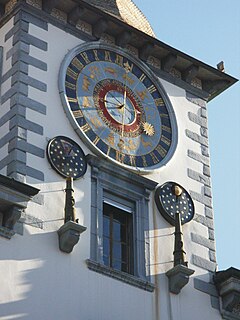
The Sion astronomical clock is an astronomical clock at the town hall of Sion in the canton of Valais, Switzerland. The clock was first installed in 1667–68; the present mechanism dates from 1902.

Fanzago's astronomical clock is an astronomical clock in Clusone, Italy. It is housed in a medieval tower in the southwest corner of the Palazzo Comunale. Dating from 1583, it was designed by local mathematician Pietro Fanzago, and still runs on its original mechanism, with restorations in 1873, 1928 and 2006.
The Bourges astronomical clock is an astronomical clock in Bourges Cathedral in Bourges, France.





















